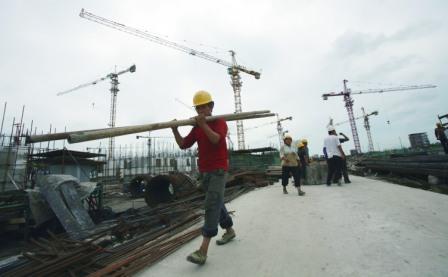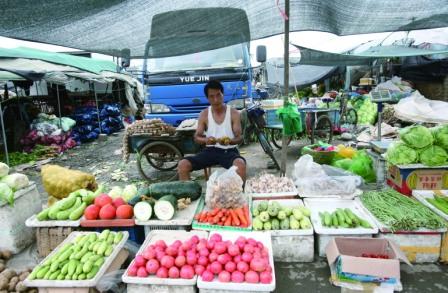

From Nation, page 14, issue 379, Aug 4, 2008
Translated by Zuo Maohong
Original article: [Chinese]
Tanghai is a coastal county in Hebei province's Tangshan city, which was devastated by a massive earthquake in 1976. Since steel giant Shougang Group moved to neighboring Caofeidian islands in 2005 and a large oil field was discovered there last year, Tanghai county has boarded the economic development express. When petroleum geologists from the Kerr-McGee Corporation set foot in Tanghai back in the 1980s, there was only one decent street and one hotel in the whole county.
When petroleum geologists from the Kerr-McGee Corporation set foot in Tanghai back in the 1980s, there was only one decent street and one hotel in the whole county.
Back then, "rapid development" was a distant dream for Tanghai, unlike other Chinese coastal cities prospering under the reform and opening-up policy.
Before 2003, there were only 20,000 permanent residents in the county, mostly retirees and workers in agricultural or auxiliary industries.
Today, most houses in the old downtown area were khaiki-colored, flat-roofed ones common to north China's countryside.
However, along the main road from Tanghai to Caofeidian, houses sporting red rooftops were lining both sides of the road, a result of the local government's urban development project under the slogan "red roofs, white walls, blue sky, and green land".
Today, the only decent street in the old days had become the "ten-mile-long street". Old apparel shops and restaurants had been moved to other streets and in their place stood imposing government buildings, banks, giant companies, and spas.
Free buses were put into operation downtown, and within three years, these free public transports would be extended to nearby villages.
The zest for urbanization and development could be felt in every corner of today's Tanghai. One housing estate's advertisement tagline quite aptly summed up the mood for change - "you might have missed the chance in Shenzhen, but don't miss Tanghai".
Shenzhen was the first Chinese city to transform from a planned into a market economy back in the late 1970s. It was the symbol of China's economic reform and the aspiration of many other Chinese cities.
In today's Tanghai, its bustling streets were full of life and a sign of prosperity. Some 1,000 private tricycles nicknamed "wooden taxies" zigzagging across the city, sourcing for customers in the streets. It was said that these drivers each could make over 2,000 yuan per month.
Zhang Danping, a civil servant in the county committee, said that in the past, people envied the employed with secure salaries, but now, street vendors and tricycle drivers made more money. 
He recalled once dining in a restaurant in Beijing, when he asked a waitress about her monthly salary and she answered 800 yuan. He was shocked - in Tanghai, even a salary of 1,200 yuan per month failed to attract applicants for the same job.
Along with high-rise buildings in Tanghai. government income, consumption levels, and housing prices were also going up.
Local treasury revenues were one marker of these trends. Between 2004 and 2007, Tanghai's yearly revenue had climbed from 80 million to 490 million yuan.
In 2005, the county's income breached the 100 million yuan mark for the first time. In a government report that year, the bureaucratic cliché "break the big barrier of 100 million" was finally dropped.
"By then, local leaders thought that the phrase 'big barrier" was undermining Tanghai," recalled Zhang.
That same year, a real estate developer invested 170 million yuan to build the first five-star hotel here - considered a rash move at the time. Today, however, the county had about ten three-star or above hotels, including one four-star and two five-stars. Usually by four in the afternoon, rooms in these hotels would have been booked up.
Moreover, to take advantage of the large area of wetland in Tanghai, a holiday resort was being built. The biggest project would be the Bohai Sea International Conference Center— the top grade conference center in Hebei .
The increased inflow of investors had given room for Tanghai to be choosy, thus raising the threshold to invest in Tanghai.
"Those (companies) with a registered capital below 30 million yuan are basically out of consideration," Zhang revealed. In addition, the investment projects should be related to the industry chain of Caofeidian.
Restaurant owner Gao Zhanfeng said he once planned to open a small budget hotel. But on a second thought, he gave up the idea, as he found visitors to Tanghai were mainly upscale customers who tended to stay in big hotels costing at least 200 yuan per night for a standard room.
Gao recalled his biggest mistake was investing in the stock market instead of the property market in 2006, when housing prices were still relatively low. He said shops bought at several hundred yuan per square meter a couple of years ago could worth ten times that price now.
Today, the migrant population in Tanghai had reached 100,000. Dormitories for staff of Jidong Oil Field and Shougang Group were under construction. Stimulated by these projects, property prices in nearby Tangshan city had also been driven up from 2,000 yuan per square meter to 7,000 yuan and were still rising.
Most homeowners in Sijihuating, the former biggest and most expensive housing estate in Tanghai, were employees of Jidong Oil Field Company. They had replaced local government employees to become the mainstream social group in the county, while flocks of migrant investors had also propped up property prices here.
Presently, Gao still had three properties at hand. Having almost missed the economic express of Tanghai, he said he was planning to expand his restaurant and start a real estate agency with some friends.
He said he would not let the opportunities to pass him by again.

